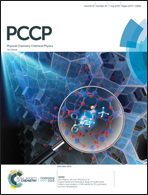Crystallization behavior of a confined CuZr metallic liquid film with a sandwich-like structure
Abstract
Despite the fact that its crystal state is thermodynamically stable, Cu64Zr36 alloy is prone to form metastable glass at a high cooling rate. However, the confinement can induce nano-crystallization with a novel sandwich-like hierarchical structure consisting of pure Cu layers, pure Zr layers and mixed layers by conducting molecular dynamics simulations. The liquid-to-crystal transition temperature and interatomic repulsion softness display abnormal oscillations, instead of monotonous variation, as the wall–wall separation increases. When the confinement size is 10 Å and 12 Å, the transition temperature reaches a maximum, resulting from the pending new sandwich layer. The atomic movement and dynamical heterogeneity are demonstrated to play a vital role in the abnormal oscillation behavior of physical properties of the nano confined metallic glass. The sandwich-like structure can alter the Cu–Zr bond fraction, which eventually influences the liquid-to-crystal transition temperature and interatomic repulsion softness. Our findings provide a deep insight into the hierarchical nanostructures and its liquid-to-crystal transition characteristics under confinement at the atomic level.



 Please wait while we load your content...
Please wait while we load your content...